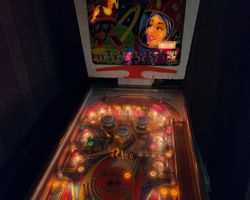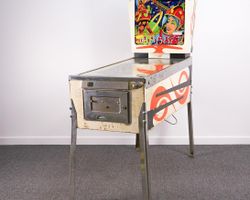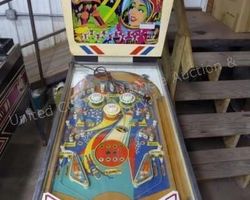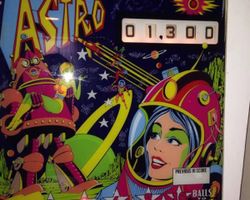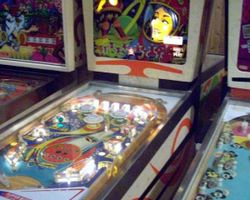Astro

Average Prices: USD $300 to $1,100
Produced: October, 1971
Production Run: 500 units
Machine Type: Electro-mechanical
Players: 1
Design by: Ed Krynski
Art by: Gordon Morison
Gottlieb’s Astro, released in October 1971, stands as a notable example of electro-mechanical (EM) pinball design from a prolific era. Manufactured by D. Gottlieb & Co., Astro was an Add-A-Ball (AAB) machine, a format that offered a distinct gameplay experience compared to traditional replay machines. Only 500 units of Astro were produced, making it a relatively scarce title. The machine’s design was a collaborative effort, with the game's layout attributed to Ed Krynski and the captivating artwork brought to life by Gordon Morison. Its theme delves into the realms of science fiction and outer space, populated by futuristic robots and cosmic vistas.
A particularly interesting aspect of Astro's identity is its relationship to another Gottlieb title from the same year. Astro is the Add-A-Ball counterpart to Gottlieb’s 4 Square, which was a replay version of essentially the same game design, albeit with different artwork. While Astro's playfield and backglass feature the prominent "Star Trek" nomenclature, it is important to note that the machine holds no official licensing ties to the popular television series. This naming choice was a common practice of the time, capitalizing on the widespread cultural resonance of a popular sci-fi theme without a formal association. The machine is housed in the classic "wedgehead" cabinet style, a signature look for Gottlieb machines of this period. This blend of original design with a commercially savvy theme, combined with its limited production, positions Astro as a distinctive piece of pinball history.
Signature Features and Design
Astro distinguishes itself through several key design elements that shape its play experience. Foremost among these is its Add-A-Ball (AAB) mechanic. Unlike typical EM machines where achieving certain objectives awards a free game, Astro rewards players with additional balls, allowing for extended play sessions as long as the player continues to meet the game's objectives. This format fostered a different kind of player engagement, shifting the focus from high scores or free games to pure longevity on the playfield.
The artwork by Gordon Morison is a defining characteristic of Astro. The backglass, in particular, has garnered significant praise, often described as beautiful, splendid, and among the most compelling space-themed artwork of its era. It depicts a vibrant, dynamic space scene featuring stylized rockets, planets, and robotic figures, perfectly encapsulating the sci-fi fantasy theme. The playfield art also received an upgrade compared to its replay sibling, 4 Square, with detailed illustrations that complement the cosmic narrative. This artistic presentation not only serves as a visual backdrop but also immerses the player in the machine's thematic world.
Beyond its striking visuals, Astro incorporates specific mechanical features that contribute to its unique gameplay. The "Wow" targets are a notable example; these targets, once lit through specific playfield objectives, award significant bonus points, becoming crucial focal points for scoring strategy. The machine utilizes two-inch flippers, which, despite their smaller size compared to modern flippers, are surprisingly effective and allow for precise ball control, enabling players to execute skilled shots necessary for success. The interplay of these elements—the AAB format, the exceptional artwork, and the targeted scoring mechanisms—defines Astro's identity and enhances the overall pinball experience.
Playfield and Mechanics
The playfield of Astro is designed with a clear, engaging layout that encourages skill shots and strategic nudging. At its core, the playfield features two flippers positioned at the bottom, providing the primary means of ball manipulation. Above the flippers, two slingshots are strategically placed to deflect the ball into the upper playfield, feeding the three pop bumpers. These pop bumpers, centrally located, are critical for accumulating points and can be boosted to 1000 points when lit, adding a dynamic scoring element to their chaotic action.
The primary objective of Astro centers around eight standup targets distributed across the playfield. These targets, when hit, contribute to spelling out "S-T-A-R-T-R-E-K." The completion of this phrase is a major goal, unlocking further scoring opportunities. In addition to these letter targets, two extra star targets must also be hit to fully light the "Wow" targets for bonus point awards. This multi-layered objective system ensures that players must engage with various areas of the playfield to progress.
The flow of Astro's playfield, though appearing simple, demands precision. Shots to the standup targets require accuracy, while the pop bumpers and slingshots generate a lively, unpredictable ball movement, demanding quick reflexes. The design philosophy behind this layout emphasizes skill over brute force, rewarding players who can control the ball and execute specific shots rather than relying solely on random deflections. The clear, vibrant artwork, particularly the sci-fi elements and robot characters, guides the player's eye across the playfield, while the lighting scheme indicates active targets and modes, making the game's progression intuitive. Despite its straightforward design, the challenging outlanes ensure that players remain vigilant, adding a layer of difficulty that keeps the game from being easily conquered.
Gameplay Dynamics
The gameplay dynamics of Astro are characterized by an elegant simplicity that belies a deceptive depth, particularly due to its Add-A-Ball format. The primary progression revolves around completing the phrase "S-T-A-R-T-R-E-K" by hitting the corresponding standup targets. Once the letters are collected, and two additional star targets are hit, the "Wow" targets light up, offering significant bonus points. Achieving these goals not only advances the player's score but also, crucially, awards extra balls, perpetuating the game. The maximum displayed score is 99,950 points, but a notable feature is the ability for the score to roll over, allowing players to rack up truly impressive totals and potentially earn additional Add-A-Balls on subsequent rounds, encouraging extended play.
While the rules are easy to grasp, mastering Astro requires a refined set of skills. It is fundamentally a "pure skill shot table," demanding precise aim to strike the standup targets and light the critical "Wow" targets. Nudging the machine plays a significant role in achieving high scores and prolonging ball times, with skilled players often using controlled movements to guide the ball or save it from draining. The game strikes a "nice sweet spot in difficulty" for earning extra balls; it is challenging enough that Add-A-Balls are not guaranteed, yet achievable enough to provide a satisfying sense of progression and reward.
One player-friendly aspect of Astro is its allowance for "spotting" players a few letters on subsequent attempts, which can keep the pop bumpers lit for high scoring and maintain player engagement even after a ball drains. This feature, combined with the general achievability of Add-A-Balls, contributes to Astro's reputation as a forgiving yet challenging game. However, the game's balance is highly reliant on proper tuning—factors like playfield steepness, rubber tension, and flipper strength all influence the game's flow and fairness. Despite the generally positive sentiment, some players note a slight frustration when the "Wow" targets are lit but the ball immediately drains, an unfortunate reality of the fast-paced gameplay. The absence of a bonus countdown at the end of each ball, a common feature in many EM games, is another minor point of feedback, but it does not diminish the core appeal of Astro's unique Add-A-Ball mechanics and focused objectives.
Reception and Legacy
Astro generally enjoys a positive reception within the pinball community, particularly among collectors who appreciate its Add-A-Ball format and distinctive EM charm. Its strengths are frequently highlighted, with the artwork, especially Gordon Morison’s backglass, consistently drawing praise for its beauty and captivating space-themed aesthetic. The core Add-A-Ball mechanic is a significant draw, offering a "smooth flow" and a satisfying sense of progression as extra balls are earned. Players often commend the game for striking a good balance; earning extra balls is achievable but not effortless, ensuring that the game remains challenging and rewarding. The effective two-inch flippers contribute to the "pure skill shot" nature of the game, allowing for precise control crucial to hitting the various standup targets. The player-friendly rules, including the ability to spot letters on subsequent attempts and the score roll-over feature, contribute to its replayability, encouraging players to return for another session.
However, Astro is not without its areas for improvement, as noted by some players. A recurring sentiment is that the gameplay, while skill-focused, can sometimes feel "simple" or "boring" to those seeking deeper rulesets or more varied objectives. The game's balance is also highly dependent on proper setup, with precise tuning of playfield steepness, rubber placement, and flipper strength being crucial for an optimal experience. Minor frustrations can arise, such as when "Wow" targets are lit for high points, only for the ball to drain immediately after. Additionally, some players miss the presence of a bonus countdown at the end of each ball, a feature common in many other EM machines that adds a sense of anticipation.
Despite these minor critiques, Astro has cemented its place in pinball history as a noteworthy example of Gottlieb’s 1970s Add-A-Ball philosophy. Its strong artistic presentation, combined with a deceptively simple yet engaging ruleset, ensured its appeal to players seeking a different kind of pinball challenge. Its legacy lies in its representation of a specific era of pinball design, where the focus was on elegant mechanics, rewarding skill, and extended play through the innovative Add-A-Ball system. Its connection to 4 Square also showcases Gottlieb's strategy of offering different payment models for the same core game. Astro remains a sought-after machine for those who appreciate the unique feel and direct engagement of an EM pinball experience.
Sponsored Links
 Ebay Listings
Ebay Listings
 Auction Results
Auction Results
| Cost | Location | Date |
|---|---|---|
| USD $650 |  New York, United States New York, United States |
08 October, 2025 |
| USD $2,950 |  Louisiana, United States Louisiana, United States |
16 September, 2024 |
| USD $1,150 |  New York, United States New York, United States |
18 March, 2023 |
| USD $1,300 |  Wisconsin, United States Wisconsin, United States |
04 February, 2021 |
| USD $1,300 |  California, United States California, United States |
31 August, 2019 |
| USD $899 |  New York, United States New York, United States |
19 February, 2015 |
| USD $1,000 |  Wisconsin, United States Wisconsin, United States |
07 February, 2014 |
| USD $1,000 |  Illinois, United States Illinois, United States |
04 November, 2013 |
| USD $40 |  Oregon, United States Oregon, United States |
23 January, 2012 |
| USD $461 |  New York, United States New York, United States |
16 October, 2011 |


Private Policy · Search Website · Contact Us
As an eBay Partner, we may earn a commission from qualifying purchases made through links on this site, at no additional cost to you.
All trademarks and copyrighted materials remain property of their respective owners. All other content copyright 2007 - 2025 Pinpedia.

